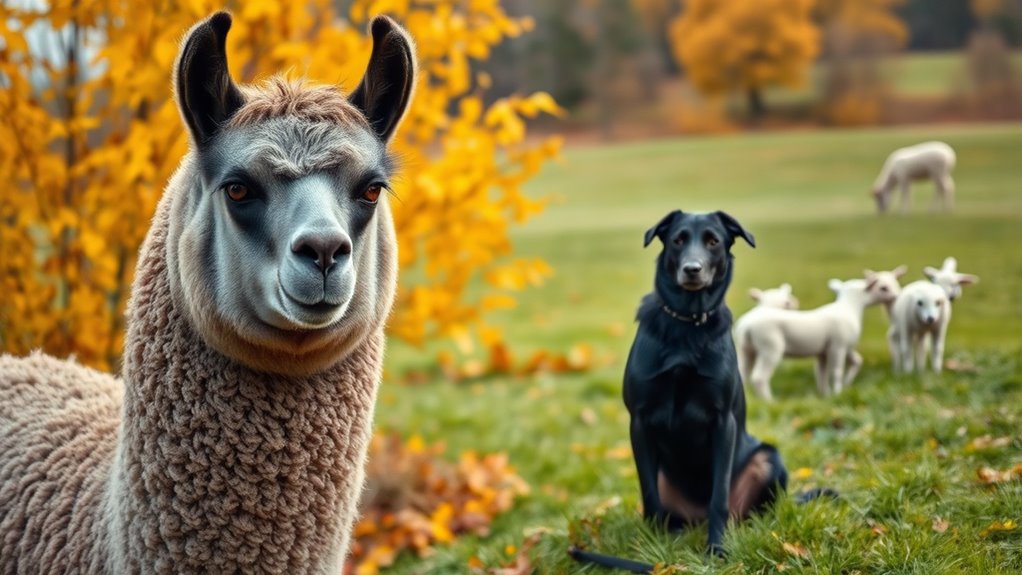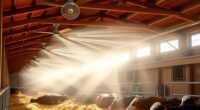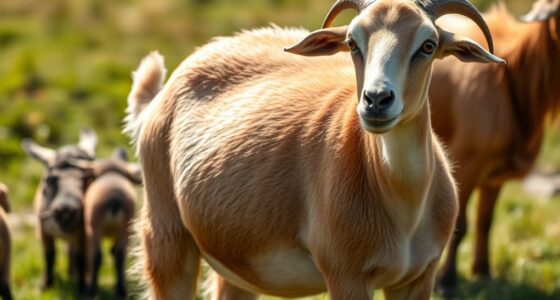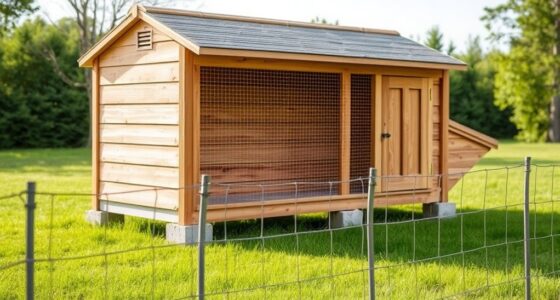Choosing the right guard animal for fall lambing depends on your needs and environment. Llamas are calm, alert, and low-maintenance, ideal for monitoring and deterring predators. Dogs offer quick response, active patrol, and immediate protection. Consider factors like temperament, training, and predator threats to make the best choice. Proper socialization and management are key to trust and effectiveness. Keep exploring to learn how to select, train, and maintain your perfect guard team.
Key Takeaways
- Assess predator threats and land size to determine whether a llama or dog provides optimal protection during fall lambing.
- Choose calm, social animals with strong guarding instincts and reliable temperament for effective flock defense.
- Ensure proper training, socialization, and routine management to maximize the animals’ responsiveness and vigilance.
- Consider low-maintenance breeds like llamas for simple care or trained guard dogs for active protection during lambing.
- Maintain health, environment, and consistent routines to keep guard animals alert, dependable, and effective throughout lambing season.
Understanding the Role of Guard Animals During Lambing Season
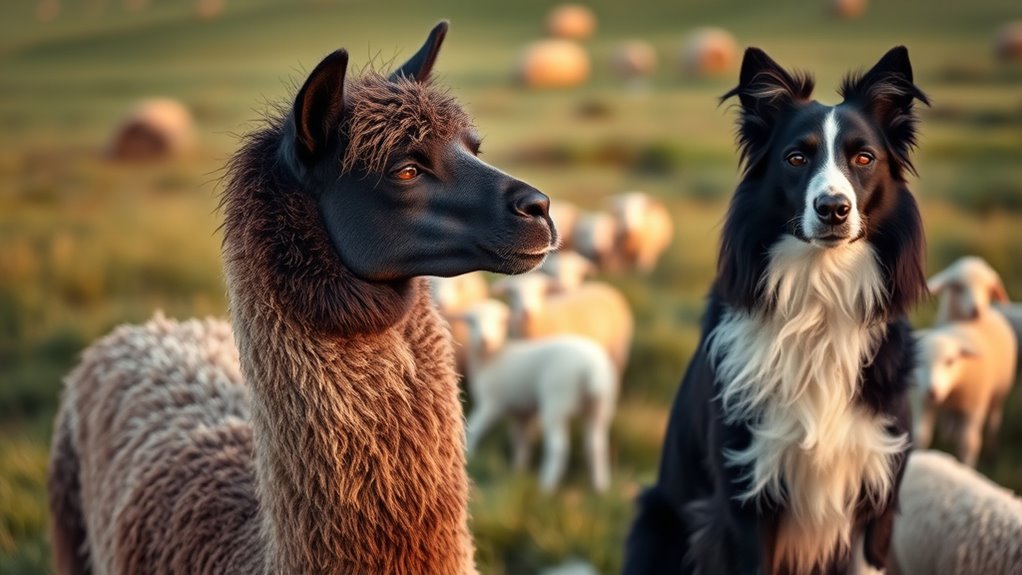
During lambing season, guard animals play a vital role in protecting vulnerable newborn lambs and their mothers from predators. Understanding predator behavior helps you choose the right guard animal, as many predators become more active during this time, seeking easy targets. Guard animals monitor herd health by alerting you to any signs of distress or threat, allowing quick responses to potential dangers. They develop strong bonds with the flock, enabling them to detect even subtle changes in predator activity or herd dynamics. By actively patrolling the area, guard animals deter predators before they can attack. Their presence not only safeguards the lambs and ewes but also promotes overall herd health, reducing stress and preventing losses during this critical period. Regular security measures and proper training further enhance their effectiveness in protecting the flock. Incorporating antique-inspired elements into your setup can create a cozy environment that encourages calmness and confidence in your guard animals, further improving their performance. Additionally, understanding guard animal behavior can help you better interpret their responses and improve their training and deployment during lambing. Recognizing the importance of familiarity with local predators can also help tailor your guard animal strategies to effectively defend your flock. Gaining knowledge about predator habits enables you to anticipate threats and optimize your protection plan effectively.
Advantages of Using Llamas as Flock Protectors
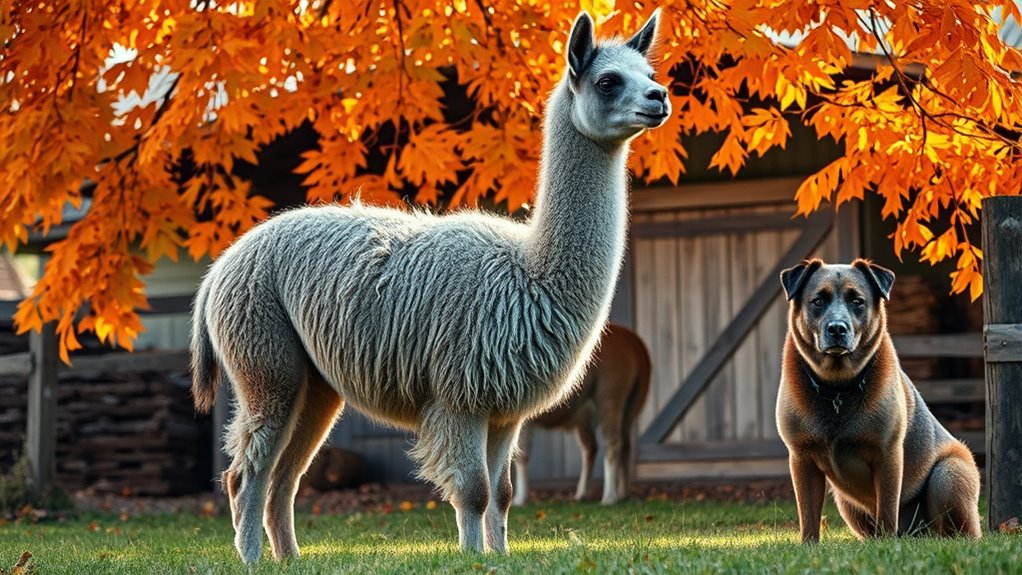
Llamas have become increasingly popular as flock protectors because of their natural instincts and alertness. They’re calm yet vigilant, making them ideal for spotting threats early. Their llama temperament is generally gentle, but they can stand their ground against predators. Unlike some dog breeds, llamas don’t require extensive training and tend to integrate well with other livestock. They’re also low-maintenance, needing little more than shelter and occasional health checks. When considering dog breed compatibility, llamas often coexist peacefully with herd dogs, especially those with calm dispositions.
| Llama Temperament | Dog Breed Compatibility |
|---|---|
| Calm, alert, protective | Compatible with calm, non-aggressive breeds |
| Independent but social | Best paired with herding or guardian dogs |
| Non-aggressive | Avoid confrontational breeds |
| Low-maintenance | Suitable for farms valuing simplicity |
Benefits of Employing Dogs for Lambing Security
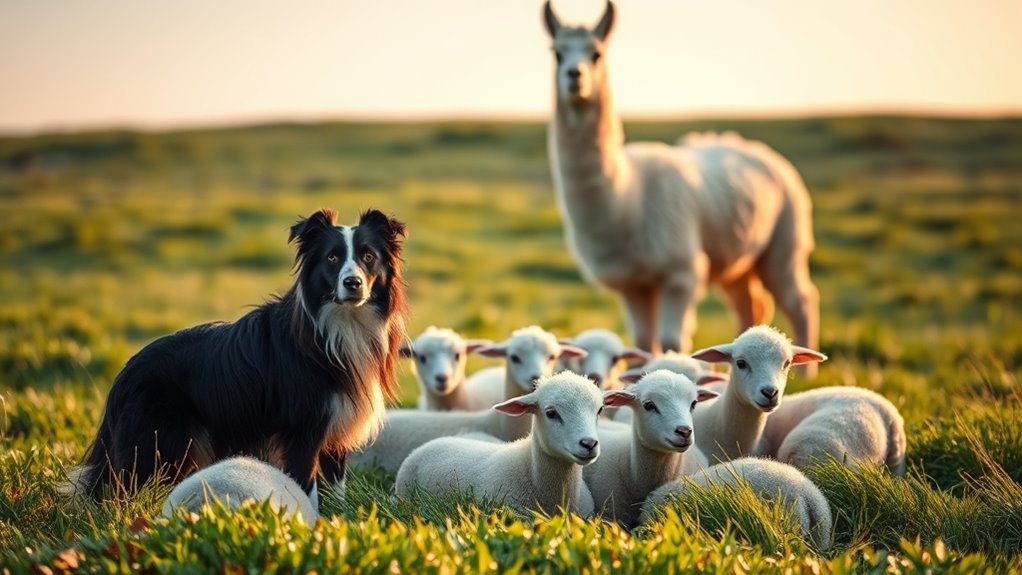
Employing dogs for lambing security offers immediate protection and peace of mind during one of the most vulnerable times for your flock. Well-trained guard dogs can detect threats early, alerting you and deterring predators, which reinforces livestock safety protocols. Their guard animal behavior is instinctive, making them loyal protectors who actively patrol and monitor the lambing area. This constant vigilance helps prevent attacks and reduces stress for both ewes and newborn lambs. Additionally, certain breeds are known for their protective instincts, ensuring a reliable safeguard for your flock. Understanding the role of contrast ratio in visual monitoring can help you better assess the environment in which your guard animals operate. Proper training and socialization are essential to maximize their effectiveness and ensure they work harmoniously with your flock. Incorporating consistent routines can further enhance their alertness and responsiveness to potential threats.
Factors to Consider When Selecting a Guard Animal
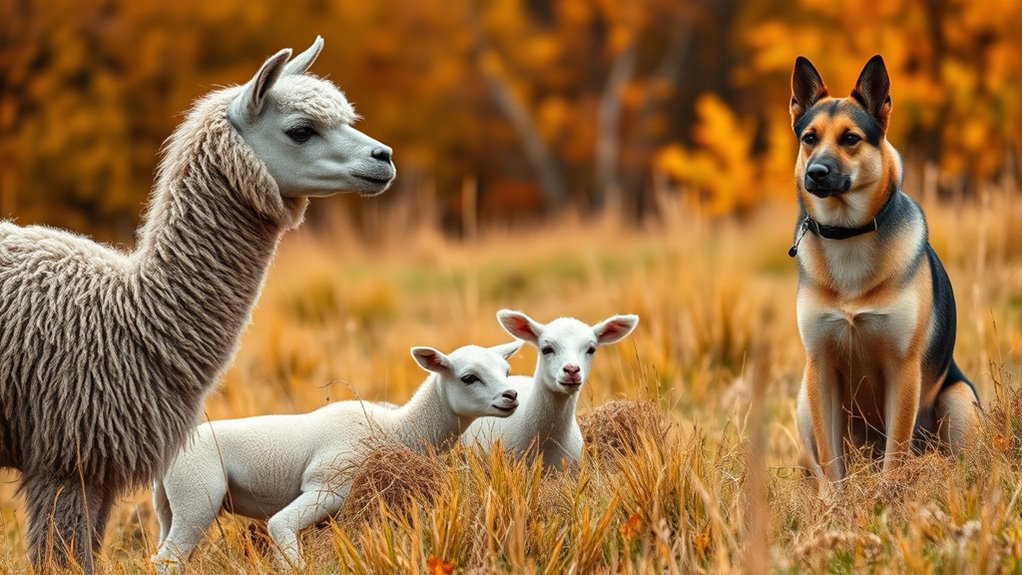
Choosing the right guard animal involves evaluating factors like size, temperament, and natural instincts to guarantee it effectively protects your flock. Cost considerations play a vital role—some breeds may require higher initial investment or ongoing care costs, so you need to balance budget with effectiveness. When selecting a breed, consider its natural guarding abilities, temperament, and compatibility with your environment. Llamas, for example, are generally low-maintenance and affordable, but dogs like Maremmas may have higher upfront costs. Also, think about your land size and predator threats, as these influence the type and size of animal you need. Additionally, understanding emotional intelligence can improve your ability to select a guard animal that will form a strong bond with your flock, ensuring better protection. Moreover, recognizing industry trends can help you choose a breed that is gaining popularity for reliable guarding. Staying informed about cultural intelligence can aid in understanding how different animals may respond to various management practices and environments, enhancing your overall selection process. Being aware of dog breeds with guard instincts, like the Black Golden Retriever, can also provide you with additional options tailored to your specific needs. Furthermore, incorporating insights from recent AI breakthroughs in animal training can optimize your approach to training and integrating your guard animal. Ultimately, selecting a guard animal that fits your budget and specific needs ensures reliable protection for your lambs throughout the fall lambing season.
Training and Socialization for Effective Guard Animals
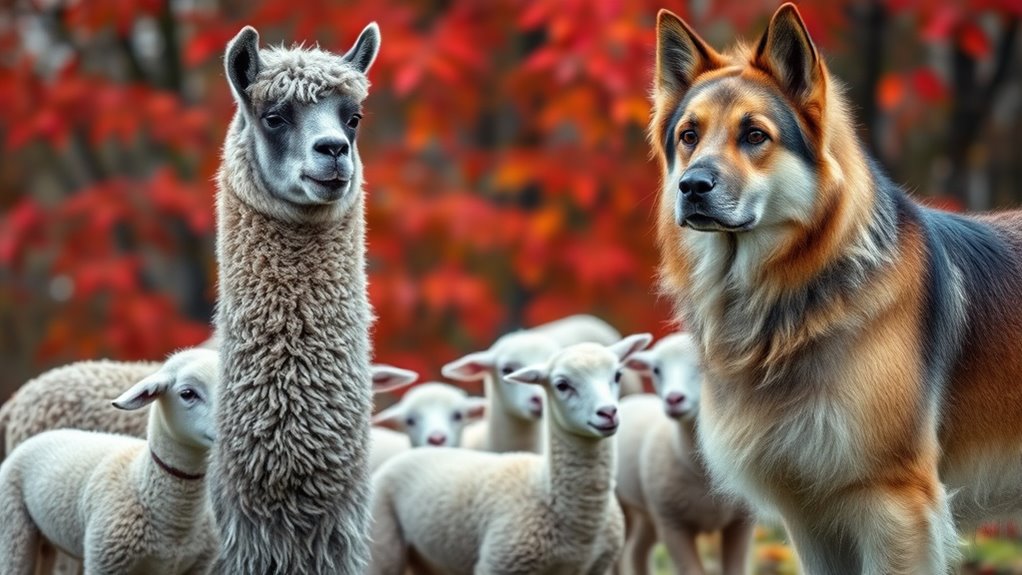
Effective training and socialization are essential to guarantee your guard animal performs its protective role reliably. Consistent canine obedience builds trust and ensures your dog responds promptly to commands, reinforcing its guarding instincts. Understanding llama temperament helps you tailor socialization, making llamas more confident and less reactive to strangers. Proper training also reduces the risk of aggression or hesitation during critical moments. Additionally, some animals may develop narcissistic behaviors if not properly socialized, which can undermine their protective effectiveness. Narcissistic behaviors can manifest as dominance or aggression, making it crucial to address socialization early. Developing a comprehensive socialization plan ensures your animal is well-prepared for various situations, enhancing its protective instincts. Regular exposure to different environments and stimuli can help prevent reactivity and promote calmness. Incorporating safety features into training routines, such as controlled exposure to potential threats, further increases your animal’s reliability. Furthermore, implementing consistent training routines facilitates better financial management of your livestock protection efforts. Imagine your guard animal confidently alerting you at the first sign of danger, providing peace of mind. – Feel the pride in knowing your dog or llama is reliably protecting your flock through well-established obedience and social bonds. – Experience the reassurance that comes with a well-socialized animal, less likely to panic or become unruly when threats arise. Effective training creates a dependable, calm protector that keeps your lambs safe and secure.
Managing and Maintaining Your Guard Animal Team
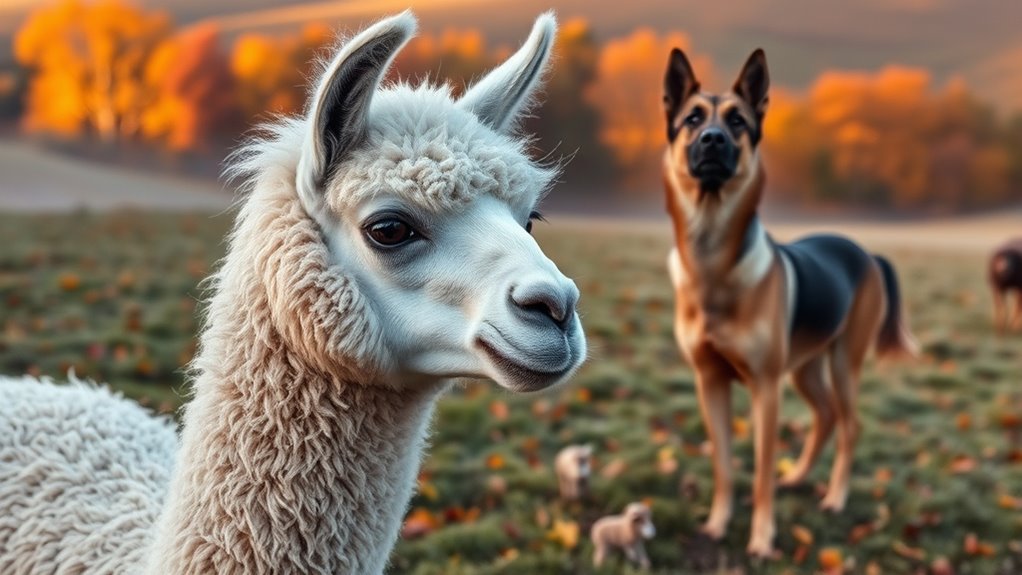
To guarantee your guard animal team remains dependable and responsive, ongoing management and maintenance are crucial. Regularly assess their guard animal diet to ensure they receive balanced nutrition that keeps them energetic and alert. Adjust their diet based on activity levels and seasonal needs. Consistently monitor their behavior and conduct predator tracking to identify potential threats early. Use surveillance tools or patrol routines to stay aware of predator activity around your flock. Keep their environment clean and secure, removing any hazards that could compromise their effectiveness. Scheduling routine health checks and training refreshers helps maintain their confidence and skills. Incorporating nutrient-rich ingredients into their diet can enhance their overall health and alertness. Additionally, providing appropriate enrichment activities can reduce stress and improve their vigilance. Staying informed about guard animal training techniques ensures your team remains effective and confident. Engaging in regular socialization can also strengthen their bond with handlers and improve responsiveness. By staying attentive to these aspects, you’ll ensure your guard animals stay vigilant, healthy, and ready to protect your lambs effectively throughout the season.
Frequently Asked Questions
How Do Guard Animals Impact Lambing Stress Levels?
You might find that guard animals substantially reduce lambing stress levels by providing predator deterrence and emotional reassurance. Their presence often encourages calm behavior in your flock, helping ewes relax during lambing. Proper behavioral training ensures your guard animals respond effectively, enhancing their protective role. This combination creates a safer environment, easing stress for both the animals and you, and promoting healthier, more successful lambing outcomes.
What Are Common Health Issues in Guard Llamas and Dogs?
Imagine your guard animal as a brave guardian, but even heroes face battles. Common health issues in guard llamas and dogs include parasites, which you can combat through regular parasite prevention, and preventable diseases like rabies or distemper, managed by sticking to vaccination schedules. Monitoring for lameness, dental problems, or skin infections is essential. Staying proactive keeps your guardian healthy, ensuring they’re always ready to protect, not struggle with preventable ailments.
Can Guard Animals Be Integrated With Other Farm Animals?
Yes, you can integrate guard animals with other farm animals successfully. Focus on fostering companion behavior by gradually introducing new animals, ensuring they bond well. Proper fencing integration is essential to keep everyone safe and secure. Monitor their interactions closely, especially initially, and provide enough space for each species. With patience and proper management, your guard animals will become effective protectors and friendly companions for your farm animals.
How Does Weather Affect Guard Animal Performance?
It’s interesting how weather unexpectedly impacts guard animal performance. You might notice that climate adaptation influences their seasonal behavior, making them more alert or sluggish depending on temperatures. Cold snaps can boost vigilance, while heat may cause fatigue and reduced responsiveness. You should regularly monitor weather patterns and adjust care routines to keep your guard animals effective, ensuring they stay alert and protective regardless of seasonal changes.
What Is the Cost Comparison Between Llamas and Dogs?
When comparing cost, you find that llamas typically have higher initial prices but lower ongoing maintenance expenses than dogs. Dogs often cost less upfront but may require regular vet visits, training, and food, increasing their overall expenses. Llamas might need minimal grooming and less frequent care, making their maintenance expenses lower over time. Your choice depends on your budget and the long-term costs you’re willing to manage.
Conclusion
Choosing the right guard animal is like planting a sturdy shield around your flock—whether it’s a vigilant llama or a loyal dog, your choice safeguards your lambs’ future. With proper training and care, these guardians become the silent sentinels watching over your flock’s peace of mind. Trust in their instincts, nurture their bond, and watch as they become the heartbeat of your lambing season’s safety—your flock’s unwavering protectors.

